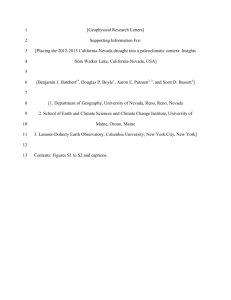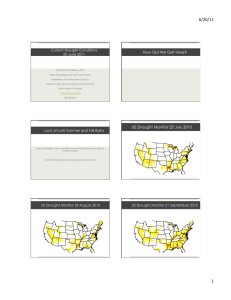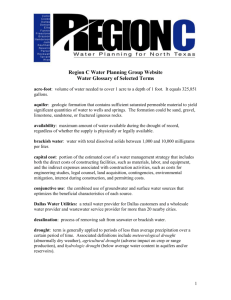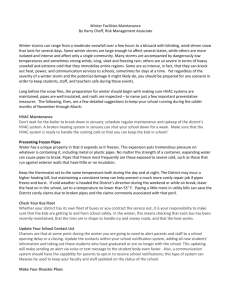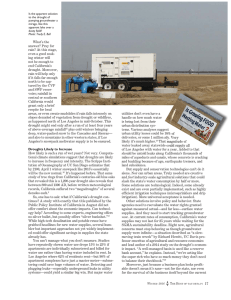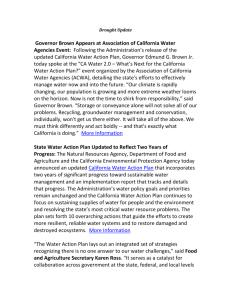usa drought 2014 case study sheet
advertisement
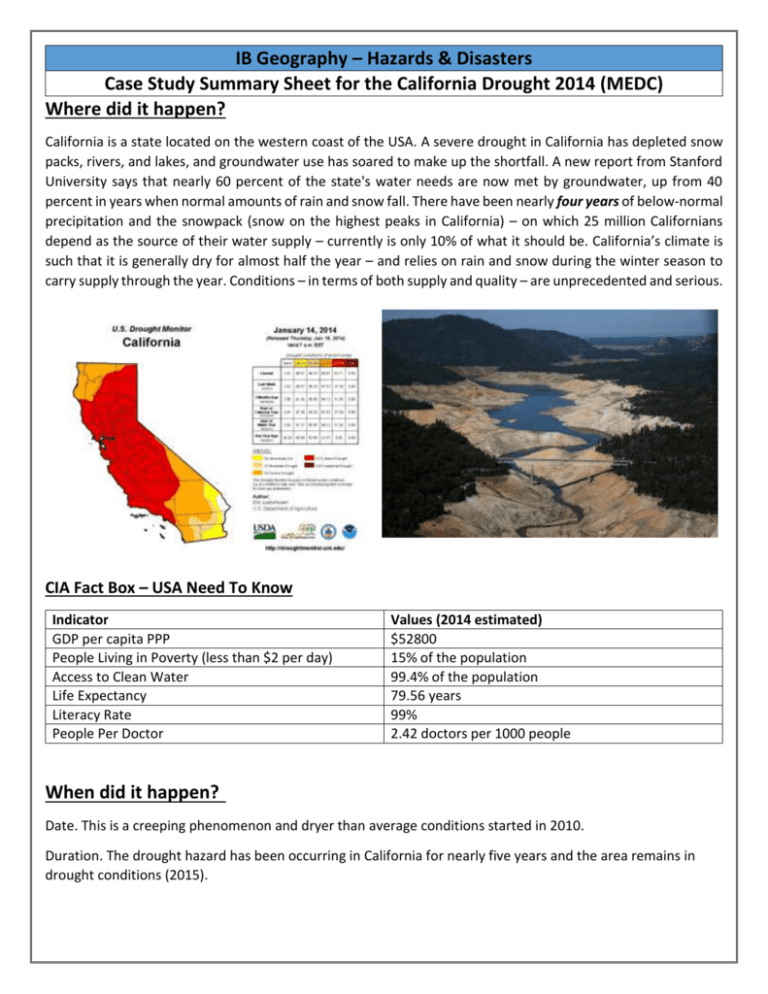
IB Geography – Hazards & Disasters Case Study Summary Sheet for the California Drought 2014 (MEDC) Where did it happen? California is a state located on the western coast of the USA. A severe drought in California has depleted snow packs, rivers, and lakes, and groundwater use has soared to make up the shortfall. A new report from Stanford University says that nearly 60 percent of the state's water needs are now met by groundwater, up from 40 percent in years when normal amounts of rain and snow fall. There have been nearly four years of below-normal precipitation and the snowpack (snow on the highest peaks in California) – on which 25 million Californians depend as the source of their water supply – currently is only 10% of what it should be. California’s climate is such that it is generally dry for almost half the year – and relies on rain and snow during the winter season to carry supply through the year. Conditions – in terms of both supply and quality – are unprecedented and serious. CIA Fact Box – USA Need To Know Indicator GDP per capita PPP People Living in Poverty (less than $2 per day) Access to Clean Water Life Expectancy Literacy Rate People Per Doctor Values (2014 estimated) $52800 15% of the population 99.4% of the population 79.56 years 99% 2.42 doctors per 1000 people When did it happen? Date. This is a creeping phenomenon and dryer than average conditions started in 2010. Duration. The drought hazard has been occurring in California for nearly five years and the area remains in drought conditions (2015). Why did it happen? Researchers said sea surface temperatures in the equatorial Pacific Ocean set up an atmospheric roadblock off the West Coast of the USA that diverted winter storms away from California. The state relies on winter rain and snow for most of its yearly water. The roadblock is a persistent ridge of high pressure that first formed in 2011 during a La Niña event. Even though La Niña broke down after the 2011-2012 winter, the western equatorial Pacific Ocean remained warmer than average, a pattern known to trigger droughts in the Southwest and California. In a new study, scientists determined that the high-pressure system, dubbed the "ridiculously resilient ridge" by a California forecaster, continued through the 2013-2014 winter because of these favorable ocean temperatures. The pool of warm water generates atmospheric winds that form patterns of high and low pressure (called planetary waves) that can get stuck off western North America as a high-pressure ridge. Who was affected by it happening? Social Impacts Economic Impacts 25 million people reliant on the snowcap and winter California has the largest agricultural industry in the rains for their water supply. USA producing nearly $45 billion a year in revenue. California’s San Joaquin Valley is the salad bowl of the Residents are asked to conserve water. It is forbidden world, providing the majority of fruits and vegetables to: for the USA. 1. Wash cars 2. Water lawns More farmers will receive economic aid from the U.S 3. Fill swimming pools government as crops cannot be planted as irrigation is impossible in places. Farmers are having to leave thousands of acres of land to fallow (no crops, being left wild). $5 billion loses in 2014 alone due to losses incurred in the agricultural sector (including wages, processing People have to pay private companies to drill private and transportation). Wine production particularly wells to extract precious groundwater supplies of affected. water. Prices of beef and grain rise due to a shortage in supply. Food prices therefore increase to the consumer. Environmental Impacts Political Impacts A huge increase in the drilling on boreholes and wells State governors asked Californians to slash their for industry and residential properties to reach water use by 20 percent. groundwater. Extraction is exceeding replenishment rates and groundwater levels are now seriously low. Fines of up to $500 per violation for breaking the rules as set out in social impacts (above) Desertification occurring in places on land that has been over cultivated. The San Francisco Public Utilities Commission has set up a number for people in San Francisco to report Increase in the number of substantial wildfires in the water wasters. It also plans to send out staff members California state. Vegetation is tinder dry and fires to write tickets for those who break the water spread quickly, engulfing large areas of the state. conservation rules. The water level in lakes is down up to 240 feet because of the drought. That's equivalent to a 24story building! What happened? *Leave this until we complete the next section on risk assessment and adjustments & responses to hazards Management of the drought in California Before the event During the event After the event - Planning, preparation, prediction, hazard mapping, evacuation, warnings. Help with recovery, aid - local, regional and international, role of NGOs. Rescue (short) Rehabilitation (Medium) Reconstruction (Long)



